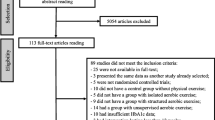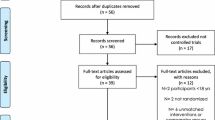Abstract
Aims
The purpose of this systematic review and meta-analysis was to examine the effects of aquatic exercise (AquaEx) on indicators of glycemic control (i.e., glycated hemoglobin [A1c] and fasting plasma glucose) in adults with type 2 diabetes mellitus (T2DM). It was hypothesized that AquaEx would improve glycemic control to a similar extent as land-based exercise (LandEx), but to a greater extent than non-exercise control (Ctrl).
Methods
A literature search was completed in February 2017 for studies examining AquaEx training in adults with T2DM. Assessment of glycemic control was necessary for inclusion, while secondary outcomes such as quality of life and cardiometabolic risk factors (i.e., blood pressure, triglycerides and total cholesterol) were considered, but not required for inclusion. Outcomes were measured before and after at least 8 weeks of AquaEx, and data were analyzed using weighted mean differences (WMDs) and fixed effect models, when appropriate.
Results
Nine trials including 222 participants were identified. Three trials compared AquaEx to LandEx, two compared AquaEx to Crtl, and four had a pre-/post-design without a comparison group. Results indicate no difference in A1c between LandEx and AquaEx (WMD = −0.02%, 95% confidence interval = [−0.71, 0.66]). Post-intervention A1c was lower in AquaEx when compared to Crtl (WMD = −0.96%, [−1.87, −0.05]). Post-AquaEx A1c was lower compared to baseline (WMD = −0.48%, [−0.66, −0.30]).
Conclusions
A1c can be reduced after eight–twelve weeks of AquaEx. However, at this time few studies have examined whether changes in A1c are different from LandEx or Crtl.



Similar content being viewed by others
Explore related subjects
Discover the latest articles and news from researchers in related subjects, suggested using machine learning.References
Canadian C (2013) Diabetes Association Clinical Practice Guidelines Expert, R.J. Sigal, M.J. Armstrong, P. Colby, G.P. Kenny, R.C. Plotnikoff, S.M. Reichert, M.C. Riddell, Physical activity and diabetes. Can J Diabetes 37(Suppl 1):S40–S44
Chudyk A, Petrella RJ (2011) Effects of exercise on cardiovascular risk factors in type 2 diabetes: a meta-analysis. Diabetes Care 34:1228–1237
Williamson DA, Rejeski J, Lang W, Van Dorsten B, Fabricatore AN, Toledo K, Look ARG (2009) Impact of a weight management program on health-related quality of life in overweight adults with type 2 diabetes. Arch Intern Med 169(2):163–171
Plotnikoff RC, Taylor LM, Wilson PM, Courneya KS, Sigal RJ, Birkett N, Raine K, Svenson LW (2006) Factors associated with physical activity in Canadian adults with diabetes. Med Sci Sports Exerc 38(8):1526–1534
Pei L, Wang Y, Sun CY, Zhang Q (2016) Individual, social and environmental predictors of regular exercise among adults with type 2 diabetes and peripheral neuropathy in China. Int J Nurs Pract 22(5):451–460
Schutzer KA, Graves BS (2004) Barriers and motivations to exercise in older adults. Prev Med 39(5):1056–1061
Cohen-Mansfield J, Marx MS, Guralnik JM (2003) Motivators and barriers to exercise in an older community-dwelling population. JAPA 11:242–253
Forbes CC, Plotnikoff RC, Courneya KS, Boule NG (2010) Physical activity preferences and type 2 diabetes: exploring demographic, cognitive, and behavioral differences. Diabetes Educ 36(5):801–815
Colberg SR, Sigal RJ, Yardley JE, Riddell MC, Dunstan DW, Dempsey PC, Horton ES, Castorino K, Tate DF (2016) Physical activity/exercise and diabetes: a position statement of the American Diabetes Association. Diabetes Care 39(11):2065–2079
Douloumpakas I, Pyrpasopoulou A, Triantafyllou A, Sampanis C, Aslanidis S (2007) Prevalence of musculoskeletal disorders in patients with type 2 diabetes mellitus: a pilot study. Kippokratia 11(4):214–218
The Cochrane Collaboration (2011) Cochrane handbook for systematic reviews of interventions version 5.1.0 [updated March 2011]. In: Hggins JPT, Green S, editors. Available from http://www.cochrane-handbook.org
Nuttamonwarakul A, Amatyakul S, Suksom D (2014) Effects of a water-based versus land-based exercise training on cutaneous microvascular reactivity and c-reactive protein in older women with type 2 diabetes mellitus. J Exerc Phys 17(4):27–33
Delevatti RS, Kanitz AC, Alberton CL, Marson EC, Lisboa SC, Pinho CD, Lovatel GA, Korb A, Bertoldi K, Macedo RC, Siqueira IR, Schaan BD, Kruel LF (2016) Glucose control can be similarly improved after aquatic or dry-land aerobic training in patients with type 2 diabetes: a randomized clinical trial. J Sci Med Sport 19(8):688–693
Suntraluck S, Tanaka H, Suksom D (2017) The relative efficacy of land-based and water-based exercise training on macro- and micro-vascular functions in older patients with type 2 diabetes. J Ag Phys Act. doi:10.1123/japa.2016-0193
Asa C, Maria S, Katharina SS, Bert A (2012) Aquatic exercise is effective in improving exercise performance in patients with heart failure and type 2 diabetes mellitus. Evid Based Complement Alternat Med 2012:349209
Nuttamonwarakul A, Amatyakul S, Suksom D (2012) Twelve weeks of aqua-aerobic exercise improve physiological adaptations and glycemic control in elderly patients with type 2 diabetes. J Exerc Phys 15(2):64–70
Cugusi L, Cadeddu C, Nocco S et al (2015) Effects of an aquatic-based exercise program to improve cardiometabolic profile, quality of life, and physical activity levels in men with type 2 diabetes mellitus. PM R 7(2):141–148
Conners RT, Morgan DW, Fuller DK, Caputo JL (2014) Underwater Treadmill Training, Glycemic Control, and Health-Related Fitness in Adults With Type 2 Diabetes. Int J Aquat Res Edu 8(4):382–396
Johnson ST, Mundt C, Boule N, Bell G, Vallance J, Taylor L, Johnson JA (2014) Improved functional status following the aquatic physical exercise for arthritis and diabetes (APEXD) study, Can J Diabetes 38(5):S63
Sporis G, Ruzic L, Nedic A (2013) The effects of aqua aerobic on patents with type 2 diabetes mellitus. Vjesn 28:33–38
Umpierre D, Ribeiro PA, Kramer CK et al (2011) Physical activity advice only or structured exercise training and association with HbA1c levels in type 2 diabetes: a systematic review and meta-analysis. JAMA 305(17):1790–1799
Boule NG, Hadden D, Kenny GP, Wells GA, Sigal RJ (2001) Effects of exercise on glycemic control and body mass in type 2 diabetes mellitus: a meta analysis of controlled clinical trials. JAMA 286(10):1218–1227
Snowling NJ, Hopkins WG (2006) Effects of different modes of exercise training on glucose control and risk factors for complications in type 2 diabetic patients: a meta-analysis. Diabetes Care 29(11):2518–2527
Nagelkerk J, Reick K, Meengs L (2005) Perceived barriers and effective strategies to diabetes self-management. J Adv Nurs 54:151–158
Thomas N (2004) Barriers to physical activity in patients with diabetes. Postgrad Med J 80(943):287–291
Nelson KM, Reiber G, Boyko EJ (2002) Diet and exercise among adults with type 2 diabetes. Diabetes Care 25(10):1722–1728
MacLeod SF, Terada T, Chahal BS, Boule NG (2013) Exercise lowers postprandial glucose but not fasting glucose in type 2 diabetes: a meta-analysis of studies using continuous glucose monitoring. Diabetes Metab Res Rev 29(8):593–603
Ross R, Dagnone D, Jones PJ, Smith H, Paddags A, Hudson R, Jannssen I (2000) Reduction in obesity and related comorbid conditions after diet-induced weight loss or exercise-induced weight loss in men. A randomized, controlled trial. Ann Intern Med 133(2):92–103
Weiss EP, Racette SB, Villareal DT et al (2006) Improvements in glucose tolerance and insulin action induced by increasing energy expenditure or decreasing energy intake: a randomized controlled trial. Am J Clin Nutr 84(5):1033–1042
Tuomilehto J, Lindstrom J, Eriksson J et al (2001) Prevention of type 2 diabetes mellitus by changes in lifestyle among subjects with impaired glucose tolerance. N Engl J Med 344(18):1343–1350
Balducci S, Zanuso S, Nicolucci A et al (2010) Effect of an intensive exercise intervention strategy on modifiable cardiovasular risk factors in subjects with type 2 diabetes mellitus. Arch Intern Med 170(20):1794–1803
Gobel S, Cysarz D, Edelhaueser F (2009) Water temperature affects heart rate and core body temperature during whole body immersion. Eur J Integr Med 1:256–257
Hulens M, Vansant G, Claessens AL, Lysens R, Muls E (2003) Predictors of 6-minute walk test results in lean, obese and morbidly obese women. Scand J Med Sci Sports 13:98–105
Acknowledgements
The authors would like to thank Allison Sivak for assisting with the computerized literature searches and Meghan Ingstrup for assisting with data extraction. This study was supported by the University of Alberta, Faculty of Physical Education and Recreation, Physical Activity and Diabetes Laboratory. Jordan Rees was supported by graduate scholarships from the Alberta Diabetes Institute and the Canadian Institutes for Health Research.
Author information
Authors and Affiliations
Corresponding author
Ethics declarations
Conflict of interest
The authors declare that they have no conflict of interest.
Human and animal rights
This article does not contain any studies with human participants or animals performed by any of the authors, with the exception of the eligible and previously published study by Johnson et al. [19].
Ethical approval
All procedures performed in the study by Johnson et al. were in accordance with the ethical standards of the University of Alberta Research Ethics Board and with the 1964 Helsinki Declaration and its later amendments or comparable ethical standards.
Informed consent
All of the eligible articles included in the meta-analysis stated that they had obtained informed consent from participants.
Additional information
Managed by Massimo Federici.
Electronic supplementary material
Below is the link to the electronic supplementary material.
Rights and permissions
About this article
Cite this article
Rees, J.L., Johnson, S.T. & Boulé, N.G. Aquatic exercise for adults with type 2 diabetes: a meta-analysis. Acta Diabetol 54, 895–904 (2017). https://doi.org/10.1007/s00592-017-1023-9
Received:
Accepted:
Published:
Issue Date:
DOI: https://doi.org/10.1007/s00592-017-1023-9




